Part I: The Best Time to Shoot the Moon
What is a full moon landscape?
My personal definition of a full moon landscape photograph is a composition in which the moon is above the horizon and also includes elements of the landscape that give the viewer a sense of re-witnessing the event photographed. This type of photograph differs from what I call “moon portraits,” which feature the moon, greatly magnified and usually alone in the sky or with minimal landscape details in the composition.
The best day for full moon photographs
Many beginners try to photograph the moon on the actual day of the full moon, usually with disappointing results. The problem is that by the time the moon appears above the horizon, the landscape is too dark to capture details in both the land and moon simultaneously.
The moon rises about 50 minutes later each day as it approaches the day of maximum fullness (astro full moon), when it rises at about the same time as the sun sets. The best day to photograph the full moon in the landscape is generally from 1-2 days before the astro full moon when it rises somewhat earlier than sunset. On those days the moon will clear the horizon and glow brightly above any hills, trees or building while there is still enough ambient light to record details in the foreground below. The trick is to choose a day that the moon’s position at sunset is high enough to clear compositional elements, but not so high that it seems disconnected to the landscape below.
Exceptions always possible
Generally speaking, on the day of the astro full moon the land is too dark by the time the moon has risen to an agreeable position in your composition. Even so, some good moonrise landscapes can be made on the day of the astro full moon if there is an unimpeded horizon or interesting shapes available that can serve as foreground silhouettes in the composition.
The best time of day for full moon photographs
The best time to catch the glow of the moon is around sunset, from several minutes prior to several minutes past the moment of sunset. Around that time the moon takes on an agreeable contrast to the sky which is beginning to darken. In deconstructing my own best moonrise photos I found that they almost always occurred within nine minutes before or after the moment of sunset. In a future lesson I will go over the tools I use for accurate prediction of day, time and place for a moonrise photograph.
Exposure considerations for moonrise landscapes.
Manual exposure only, please!
Using auto exposure during the optimum time for photography (see above) will generally cause extreme over-exposure of the moon. Since the foreground has already darkened, the camera will attempt to bring more light (excessively) into the photo. Your foreground may look great but you’ll get a blank moon that looks more like the sun.
Start with Loony Eleven and bracket to +3
Loony Eleven defined: With aperture set on f/11, set your shutter speed to same number as your ISO setting. ie: if ISO is set to 200, then set your shutter speed to 1/200 sec. Then bracket in full stops to +3 by adjusting your shutter only. In this example your series would be:
Aperture f/11, ISO 200 shutter: 1/200, 1/100, 1/50, 1/25. Back at your computer examine your results. You may find, like me, that in the future you only need to make a couple of these exposures. From my own experience I determined to just make the +1 and +2 for most moonrises.
I hope you found the information above interesting and perhaps useful. In the Part II I’ll write about the methods and tools I use to predict where and when to be for the next great moonrise photo opportunity!
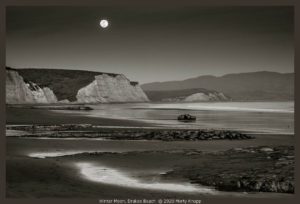
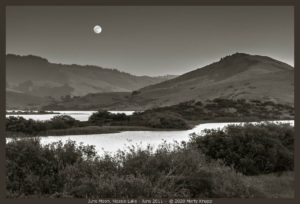
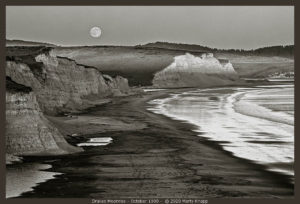
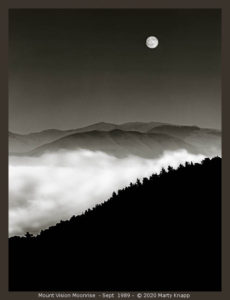
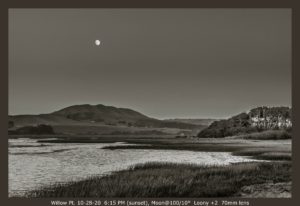
Pingback: On Assignment: Moon Scenery - Lenspiration
Thanks very much, both for the photos and the information.
It also helps to turn on highlight alert “blinkies” to avoid overexposing the moon. Even if the foreground appears dark, a great deal of shadow detail can be recovered post-capture when using most current digital cameras.
I’d heard of the “sunny 16”; from whence came “loony 11?” Ah, from “lunar?”
Thanks Marty, this is definitely going to change how I shoot this kind of photo!
Thank you Marty,
Enlightening! And beautiful! The first photo is the most arresting because of the reflections of the moonlight in the wet sand.
Always a pleasure to see your wonderful photos of such a beautiful place,
Cathy